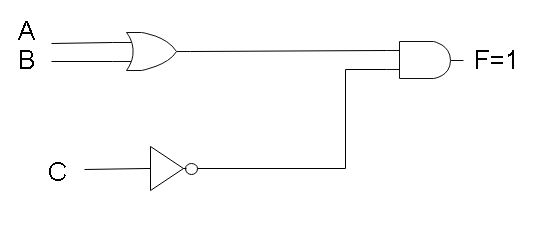
For the given logic diagram, output \[F = 1\] , then inputs are:

A) \[A = 0,B = 0,C = 0\]
B) \[A = 0,B = 1,C = 0\]
C) \[A = 1,B = 1,C = 1\]
D) \[A = 0,B = 0,C = 1\]
Answer
216.6k+ views
Hint: In this solution, we will find the logic equation for the output of F. A and B terminals are connected to an OR gate while C is connected to a NOT gate.
Complete step by step answer:
As given in the image, we can see that A and B are connected to an OR gate.
This gives an output of $A + B$
The C terminal is connected to a NOT gate which gives us output $\bar C$
Both these gates are then connected by an AND gate so the net output would be
$F = \left( {A + B} \right).\bar C$
For the output F to be 1, we can see that both of the inputs of the final and gate must be one. Hence for the input coming from the C terminal to be 1, the input of C must be zero i.e. $C = 0.$
For the input coming from the A or B gate, either A or B must be one. From the options, we can see that the only option satisfying the above conditions is option (B).
The configuration \[A = 0,B = 1,C = 0\] will give an output of 1 in the following way. The combination of A OR B will give a 1 since $B = 1$. The output of $\bar C$ will be 1 since the input of C is zero.
Hence the combination of both inputs of the AND gate is 1 so the final output will also be 1.
Hence the correct choice is option (B).
Note: In such questions, it is helpful to check all the options one by one to determine which set of inputs will give the output of 1. So we must be aware of the output table of different kinds of logic gates to answer this question.
Complete step by step answer:
As given in the image, we can see that A and B are connected to an OR gate.
This gives an output of $A + B$
The C terminal is connected to a NOT gate which gives us output $\bar C$
Both these gates are then connected by an AND gate so the net output would be
$F = \left( {A + B} \right).\bar C$
For the output F to be 1, we can see that both of the inputs of the final and gate must be one. Hence for the input coming from the C terminal to be 1, the input of C must be zero i.e. $C = 0.$
For the input coming from the A or B gate, either A or B must be one. From the options, we can see that the only option satisfying the above conditions is option (B).
The configuration \[A = 0,B = 1,C = 0\] will give an output of 1 in the following way. The combination of A OR B will give a 1 since $B = 1$. The output of $\bar C$ will be 1 since the input of C is zero.
Hence the combination of both inputs of the AND gate is 1 so the final output will also be 1.
Hence the correct choice is option (B).
Note: In such questions, it is helpful to check all the options one by one to determine which set of inputs will give the output of 1. So we must be aware of the output table of different kinds of logic gates to answer this question.
Recently Updated Pages
Wheatstone Bridge Explained: Working, Formula & Uses

Young’s Double Slit Experiment Derivation Explained

JEE Atomic Structure and Chemical Bonding important Concepts and Tips

JEE Amino Acids and Peptides Important Concepts and Tips for Exam Preparation

Electricity and Magnetism Explained: Key Concepts & Applications

Chemical Properties of Hydrogen - Important Concepts for JEE Exam Preparation

Trending doubts
JEE Main 2026: Application Form Open, Exam Dates, Syllabus, Eligibility & Question Papers

Derivation of Equation of Trajectory Explained for Students

Hybridisation in Chemistry – Concept, Types & Applications

Understanding the Angle of Deviation in a Prism

Understanding Collisions: Types and Examples for Students

How to Convert a Galvanometer into an Ammeter or Voltmeter

Other Pages
JEE Advanced Marks vs Ranks 2025: Understanding Category-wise Qualifying Marks and Previous Year Cut-offs

Understanding Atomic Structure for Beginners

Ideal and Non-Ideal Solutions Explained for Class 12 Chemistry

Degree of Dissociation: Meaning, Formula, Calculation & Uses

Understanding Electromagnetic Waves and Their Importance

Understanding the Electric Field of a Uniformly Charged Ring




